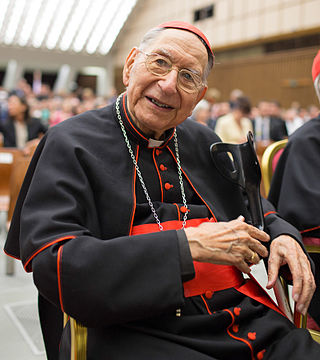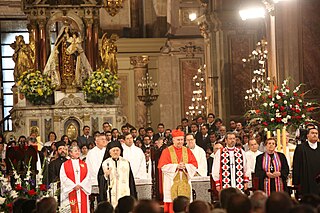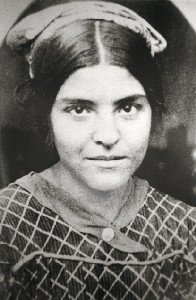Unitatis redintegratio is the Second Vatican Council's decree on ecumenism. It was passed by a vote of 2,137 to 11 of the bishops assembled at the Council, and was promulgated by Pope Paul VI on 21 November 1964.
Full communion is a communion or relationship of full agreement among different Christian denominations or Christian individuals that share certain essential principles of Christian theology. Views vary among denominations on exactly what constitutes full communion, but typically when two or more denominations are in full communion it enables services and celebrations, such as the Eucharist, to be shared among congregants or clergy of any of them with the full approval of each.

Ecumenism, also spelled oecumenism, is the concept and principle that Christians who belong to different Christian denominations should work together to develop closer relationships among their churches and promote Christian unity. The adjective ecumenical is thus applied to any interdenominational initiative that encourages greater cooperation and union among Christian denominations and churches.

The Catechism of the Catholic Church is a reference work that summarizes the Catholic Church's doctrine. It was promulgated by Pope John Paul II in 1992 as a reference for the development of local catechisms and as "useful reading for all other Christian faithful". It has been translated into and published in more than twenty languages worldwide.

Georges Marie Martin Cottier O.P., was a Swiss prelate and theologian of the Catholic Church who served from 1990 to 2005 as theologian to Pope John Paul II as Theologian of the Pontifical Household after a career as a theologian and teacher. He was made a cardinal in 2003.
Satis cognitum is an encyclical of Pope Leo XIII dated 29 June 1896 on the unity of the Church, and some heresies of his time.

Demetrios I, also Dimitrios I or Demetrius I, born Demetrios Papadopoulos was, as a successor to St. Andrew, the 269th Ecumenical Patriarch of Constantinople from July 16, 1972, to October 2, 1991, serving as the spiritual leader of 300 million Eastern Orthodox Christians. Before his election as patriarch, he served as the metropolitan bishop of Imvros. He was born and died in Constantinopole, in modern-day Turkey.
Fides et ratio is an encyclical promulgated by Pope John Paul II on 14 September 1998. It was one of 14 encyclicals issued by John Paul II. The encyclical primarily addresses the relationship between faith and reason.
Veritatis splendor is an encyclical by Pope John Paul II. It expresses the position of the Catholic Church regarding fundamentals of the Church's role in moral teaching. The encyclical is one of the most comprehensive and philosophical teachings of moral theology in the Catholic tradition. It was promulgated on 6 August 1993. Cardinal Georges Cottier was influential in drafting the encyclical, as was Servais-Théodore Pinckaers, a professor of moral theology at the University of Fribourg.
Irenicism in Christian theology refers to attempts to unify Christian apologetical systems by using reason as an essential attribute. The word is derived from the Greek word ειρήνη (eirene) meaning peace. It is a concept related to a communal theology and opposed to committed differences, which can cause unavoidable tension or friction, and is rooted in the ideals of pacifism. Those who affiliate themselves with irenicism identify the importance of unity in the Christian Church and declare the common bond of all Christians under Christ.

The Catholic Church has engaged in the modern ecumenical movement especially since the Second Vatican Council (1962-1965) and the issuing of the decree Unitatis redintegratio and the declaration Dignitatis humanae. It was at the Council that the Pontifical Council for Promoting Christian Unity was created. Those outside of the Catholic Church were categorised as heretics or schismatics, but in many contexts today, to avoid offence, the euphemism "separated brethren" is used.
Ecclesia de Eucharistia is an encyclical by Pope John Paul II published on April 17, 2003. Its title, as is customary, is taken from the opening words of the Latin version of the text, which is rendered in the English translation as "The Church draws her life from the Eucharist". He discusses the centrality of the Eucharist to the definition and mission of the Church and says he hopes his message will "effectively help to banish the dark clouds of unacceptable doctrine and practice, so that the Eucharist will continue to shine forth in all its radiant mystery." He explored themes familiar from his earlier writings, including the profound connection between the Eucharist and the priesthood. It drew as well on his personal experiences saying Mass.
Subsistit in is a Latin phrase which appears in Lumen gentium, the document on the church from the Second Vatican Council of the Catholic Church. Since the council, the reason for use of the term "subsists in" rather than simply "is" has been disputed. Generally, those who see little or no change in church teaching in Vatican II insist on the equivalence of subsistit in and "is". Those who point to a new, ecumenical thrust in Vatican II insist that the term was introduced as a compromise after much discussion, and acknowledges new elements in the council's teaching.

"That they all may be one" is a phrase derived from a verse in the Farewell Discourse in the Gospel of John (17:21) which says:
that they may all be one. As you, Father, are in me and I am in you, may they also be in us, so that the world may believe that you have sent me.

Maria Sagheddu - in religious Maria Gabriella - was an Italian Catholic professed religious and a professed member from the Trappists. Sagheddu had an intense spiritual devotion to ecumenism - something for which she had offered her life - since she desired that all would become one in Jesus Christ. Her childhood saw her noted as stubborn and obstinate though her increased activeness in teaching catechism and joining Azione Cattolica saw those qualities melt and become gentleness and careful attentiveness.

The Catholic Church and the Eastern Orthodox Church have been in a state of official schism from one another since the East–West Schism of 1054. This schism was caused by historical and language differences, and the ensuing theological differences between the Western and Eastern churches.
The Dicastery for Promoting Christian Unity, previously named the Pontifical Council for Promoting Christian Unity (PCPCU), is a dicastery within the Holy See whose origins are associated with the Second Vatican Council which met intermittently from 1962 to 1965.
Sister churches was a term used in 20th-century ecclesiology to describe ecumenical relations between the Roman Catholic Church and the Eastern Orthodox Churches, and more rarely and unofficially, between the Roman Catholic Church and the Anglican communion. The Catholic Church has since called on theologians to avoid the term, clarifying that "one cannot properly say that the Catholic Church is 'sister' of a particular Church or group of Churches. This is not merely a question of terminology, but above all of respecting a basic truth of the Catholic faith: that of the unicity [uniqueness] of the [Catholic Church]." The term is also currently used among Protestants to refer to different denominations of the same religious tradition.

Catholic ecclesiology is the theological study of the Catholic Church, its nature and organization, as described in revelation or in philosophy. Such study shows a progressive development over time. Here the focus is on the time leading into and since the Second Vatican Council (1962–1965).

Catholic–Eastern Orthodox relations have warmed over the last century, as both churches embrace a dialogue of charity. The Second Vatican Council (1962-1965) ushered in a new era of relations for the Catholic Church towards the Eastern Church, fondly describing the Orthodox as “separated brethren” with valid sacraments and an apostolic priesthood. The Orthodox Church, on the other hand, encouraged local churches to prepare for future dialogue in the Third Pan-Orthodox Conference in Rhodes (1964), and has since engaged in several ecumenical efforts with the Vatican. Significantly, in 1965 Pope Paul VI and Ecumenical Patriarch Athenagoras I of Constantinople mutually lifted their respective excommunications.











